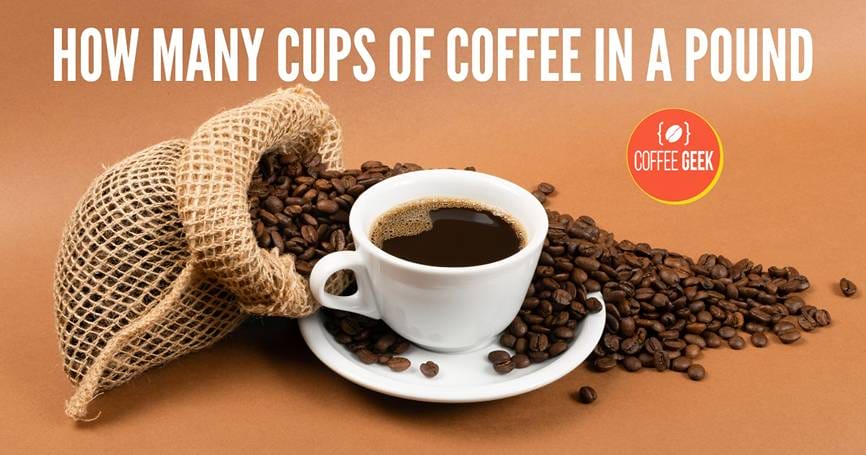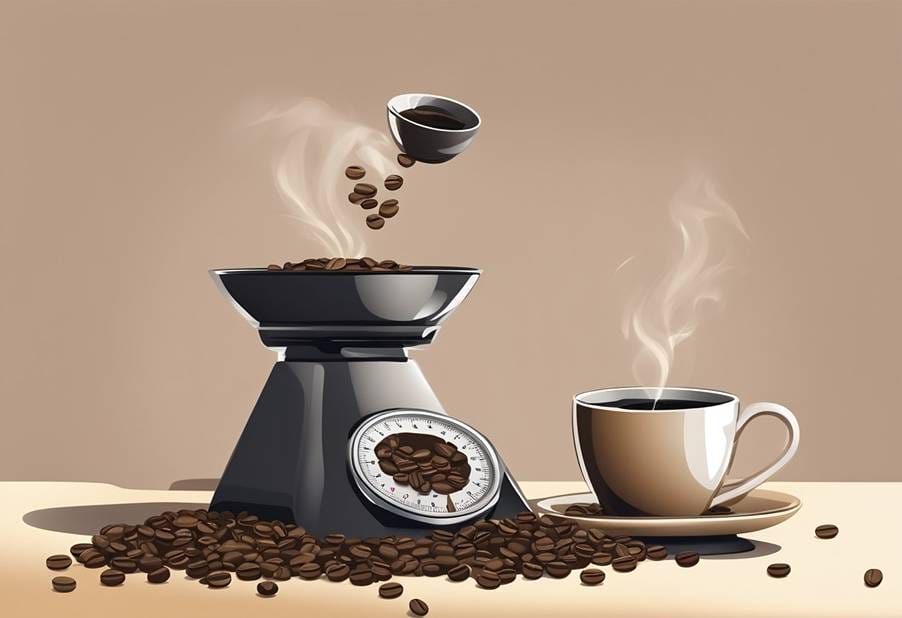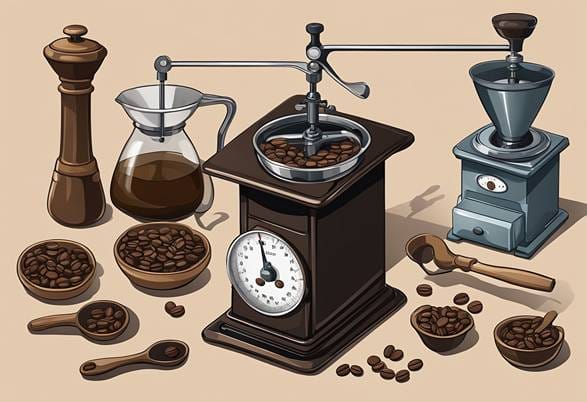Are you curious about how many cups of coffee can be made from a pound of beans or grounds?
The answer, while not precise, can provide valuable insights that will help maximize your coffee enjoyment and budget.
Factors such as brewing methods, coffee grind size, and coffee-to-water ratios impact the number of cups that can be produced from one pound of coffee.
With so many variables, it’s intriguing to learn the basics of these factors and how they affect your daily cup of joe.
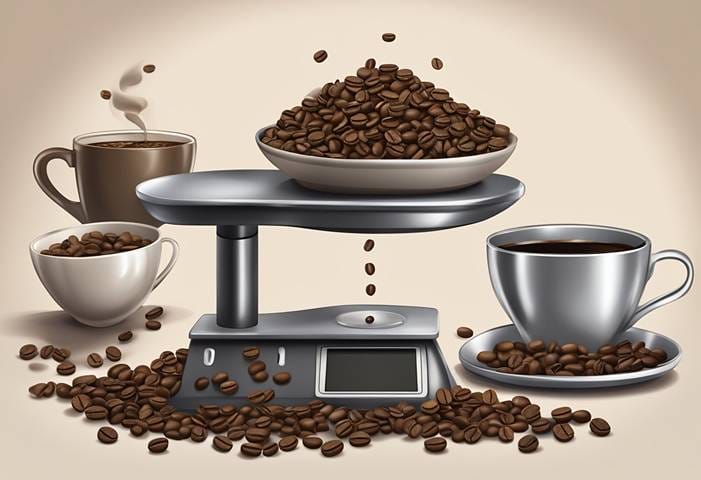
Understanding the connection between a pound of coffee and the number of cups it yields can help you calculate your coffee consumption and plan your coffee purchases accordingly.
Coffee aficionados are aware of the importance of precision in measuring and brewing their favorite beverage, and grasping these concepts can improve your overall coffee experience.
Whether you want to master your coffee-making skills or simply wish to know how much coffee you need to buy to make your daily cups, knowing the number of cups in a pound is a valuable piece of information.
Key Takeaways
- Several factors such as coffee grind size, brewing method, and coffee-to-water ratios affect the number of cups that can be produced from one pound of coffee.
- Establishing a connection between coffee poundage and the number of cups can help manage your coffee consumption and budget.
- Learning the basics of coffee measurement and brewing can enhance your overall coffee-making skills and experience.
How Many Cups of Coffee in A Pound?
So, you’re wondering about how many cups of coffee you can get from a pound of coffee beans.
The answer can vary depending on factors like the brewing method, serving size, and how much ground coffee you use per cup.
On average, you can make about 30 cups of coffee with one pound of coffee. Here are some helpful insights to consider while brewing your perfect cup of coffee.
Firstly, let’s look at the coffee-to-water ratio.
The Specialty Coffee Association suggests an optimal ratio of 1:18, meaning 55 grams of coffee for every liter of water.
This is a good starting point, but you may prefer a stronger or lighter cup of coffee, so feel free to experiment with the coffee ratio calculator to find your perfect balance.
Another factor that influences the number of cups you can get from a pound of coffee is the serving size.
Traditionally, a cup of coffee is considered to be 6 fluid ounces.
However, some coffee companies measure a cup as 4 or 5 ounces. If you’re using an 8-ounce cup, you may get slightly fewer cups from your pound of coffee.
Moreover, the grind size plays a role in determining the number of cups per pound.
Finer grind size requires more coffee per cup, while a coarser grind size uses less coffee, resulting in a varying amount of cups.
A standard measurement for making one cup of coffee is 2 tablespoons of coffee per 6 ounces of water.
Just to set things into perspective, here’s a quick glance at an estimated number of cups per pound for different brewing methods:
- Drip coffee: 30-32 cups
- French press: 28-30 cups
- Espresso: 60-70 double shots
Keep these factors in mind, and you’ll be able to estimate how many cups of coffee you can get from your pound of coffee. Happy brewing!
The Basics of Coffee Measurement
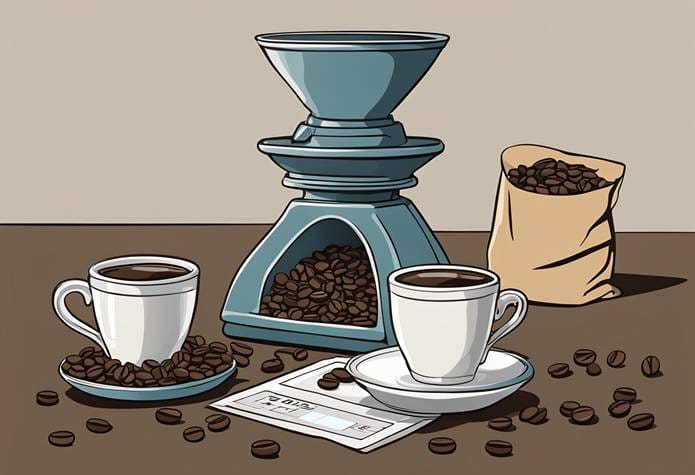
Understanding the Pound
When it comes to measuring coffee, it’s essential to know that a pound of coffee consists of 16 ounces or approximately 453 grams.
This may vary slightly depending on the type of beans and their density, but it’s a good starting point for understanding coffee measurements.
With this knowledge, you can better estimate the number of cups you can brew from a pound of coffee.
Coffee Cup Sizes and Measures
There is a wide range of coffee cup sizes, which can make determining the number of cups per pound a bit tricky.
A standard cup of coffee typically holds 8 ounces of liquid.
However, many coffee shops serve beverages in larger sizes, such as 12 or 16 ounces.
As a general rule of thumb, you can expect to get around 34 to 48 cups of coffee from a pound.
Keep in mind that these figures will vary depending on your personal preferences and brewing methods.
Experimenting with different brewing ratios and measurements can help you achieve the perfect balance between taste and strength.
As a general guideline, it is recommended to use 2 tablespoons of coffee grounds per 6 ounces of water.
This equates to roughly 10 grams of coffee per cup. However, feel free to adjust the measurements according to your taste preferences and brewing method.
In conclusion, understanding the relationship between a pound of coffee and the number of cups you can brew from it can help you better plan your coffee consumption and purchases.
By experimenting with different brewing ratios and measurements, you can find the perfect formula to make a delicious cup of coffee that suits your tastes perfectly.
Coffee Beans and Grounds
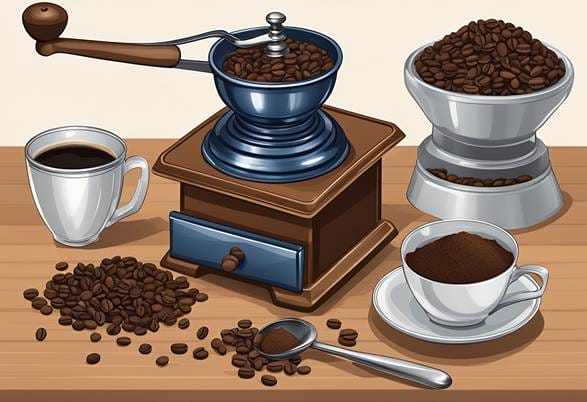
Whole Beans Versus Ground Coffee
When it comes to enjoying your coffee, you might wonder whether to choose whole beans or ground coffee.
Each option has its own benefits and drawbacks, which can affect the taste and quality of the final cup.
Whole bean coffee is generally considered fresher since it retains its flavors and aromas longer than pre-ground coffee.
Grinding your Arabica or Robusta beans right before brewing ensures that you are extracting the most flavor from the coffee.
This is because the natural oils and volatile compounds in coffee deteriorate more quickly once the beans are ground, so using whole beans helps preserve the coffee’s taste.
However, ground coffee offers convenience and can save time in your busy morning routine.
If you’re always on the go or don’t have a grinder at home, ground coffee can be a practical choice.
Keep in mind that different brewing methods might require different grind sizes for optimal extraction, so make sure you choose the right grind size for your brewing method.
Importance of Grind Size
Grind size plays a significant role in determining the taste and quality of your coffee.
The particle size of the coffee grounds influences the extraction rate, which affects the balance of flavors in your cup.
Here’s a quick guideline to help you understand how grind size affects your coffee:
- Coarse grind: Best for French press, percolators, and cold brew. The larger particles allow for slower extraction, which suits these brewing methods.
- Medium grind: Ideal for drip coffee makers and pour-over methods like Chemex and Hario V60. It offers a balanced extraction rate, resulting in a well-rounded taste.
- Fine grind: Perfect for espresso and AeroPress. The small particles lead to a faster extraction, producing a rich and bold flavor.
- Extra fine grind: Used for Turkish coffee. It creates a thicker and more intense flavor profile.
Experimenting with grind size can help you find the perfect balance of flavors for your taste buds.
Remember that factors like the coffee bean type, brewing method, and water quality all play a role in determining the taste of your final cup.
Adjusting the grind size is just one of many ways you can fine-tune your coffee experience.
Brewing Methods And Ratios
In this section, we’ll discuss various brewing methods like espresso, French press, and drip coffee, highlighting their coffee-to-water ratios and technique.
We will also cover pour-over coffee and other methods for completeness.
Ultimately, your choice of brew method will determine the number of cups of coffee you can extract from a pound.
Espresso and Its Variables
The espresso method extracts a small, concentrated amount of coffee and is typically served in 1-ounce shots.
An espresso machine uses pressure to force hot water through finely-ground coffee beans.
The ideal brew time should be between 25 and 35 seconds, with a common brew ratio of two times the dry coffee dose (e.g., 18 grams of dry coffee produces 36 grams of liquid espresso).
To achieve the perfect espresso, consider the following:
- Grind: Fine grind for optimal extraction
- Dose: Adjust the coffee amount to suit your taste
- Brew ratio: Experiment with ratios between 1:1 and 1:3 dry coffee to water
French Press Methodology
The French press is a popular manual brewing method which steeps coarsely ground coffee in hot water and then separates the grounds with a metal mesh filter.
The optimal coffee-to-water ratio for French press coffee is 1:18, meaning 55 grams of coffee for every liter of water.
Here’s a quick guide:
- Grind: Use coarse grounds for best results
- Ratio: 1:18 coffee to water
- Steep time: Steep for 4 minutes and then press the plunger
Drip Coffee and Pour-Over Differences
Drip coffee makers and pour-over methods such as the V60 create coffee by passing hot water through a bed of coffee grounds and a paper filter.
The main difference between these methods lies in the control each offers during the brewing process, with pour-over allowing for manual adjustments to water flow and temperature.
For both methods, use a coffee-to-water ratio of 1:16 to 1:18 and an 8-ounce cup size as the standard.
Consider the following for each brewing technique:
- Drip coffee
- Brew time: 4-6 minutes
- Grind: Medium grind
- Cup size: 8 ounces
- Pour-over
- Brew time: 3-4 minutes
- Grind: Medium-fine grind
- Concentrate on even water distribution for balanced extraction.
Remember, different brewing methods will yield a varying number of cups of coffee from a single pound of beans.
Experiment with the ratios and techniques discussed here to find the method and taste that suit your preferences best.
Precision in Coffee Making

Measurement Tools and Techniques
When it comes to making the perfect cup of coffee, precise measurements are essential.
To get started, you’ll need some basic measurement tools such as a digital scale, measuring spoons, and a measuring cup.
Use a digital scale for the most accurate results, especially when measuring coffee beans or grounds.
Weigh your coffee in grams for best results. For volume measurements, use a tablespoon and a measuring cup for liquids.
Measuring coffee is an important step because different brewing methods require different amounts of coffee and water.
This means that the coffee-to-water ratio can greatly impact the taste of your final cup.
An accurate digital scale helps ensure consistency in your measurements, while measuring spoons are useful for scooping the correct amount of coffee grounds.
Calculating Coffee to Water Ratios
The coffee-to-water ratio plays a crucial role in determining the strength and flavor of your coffee.
Generally, a ratio of 1:15 to 1:18 is recommended, meaning 1 part coffee to 15 to 18 parts water.
This translates to approximately 2 tablespoons of coffee per 6 ounces of water for a standard cup of coffee.
Remember that the grind size of the coffee can also influence the taste, as coarser grind sizes require less coffee per cup, resulting in more cups per pound, while finer grind sizes require more coffee per cup, resulting in fewer cups per pound1.
By using the appropriate measurement tools and techniques and understanding the importance of coffee-to-water ratios, you can achieve precision in your coffee making process, resulting in a consistently delicious cup of coffee every time.
| Brewing Method | Approximate Cups per Pound |
|---|---|
| Espresso | 25-30 cups |
| French Press | 18-22 cups |
| Drip Coffee Maker | 28-34 cups |
| Pour Over | 25-30 cups |
| AeroPress | 30-35 cups |
| Cold Brew | 10-15 cups |
| Turkish Coffee | 40-50 cups |
Conclusion
Understanding how many cups of coffee one can get from a pound of coffee is crucial for both coffee enthusiasts and casual drinkers alike.
The number of cups from a coffee per pound can vary significantly depending on the type of coffee, the brewing method, and personal taste preferences such as how strong or light you like your coffee.
Typically, a pound bag of coffee can yield approximately thirty-two 8 fluid ounces cups of coffee when using the standard measurement of one tablespoon of coffee grounds per 6 ounces of water.
However, for those who prefer a stronger cup, using two tablespoons per cup, the yield might be closer to half, at around sixteen cups per pound.
When it comes to making espresso, the calculation changes due to the higher concentration of coffee to water.
A pound of coffee grounds can produce around thirty-two shots of espresso, considering that each shot uses about 7.5 grams of coffee.
This variation highlights the importance of weighing out your coffee and understanding the coffee-to-water ratio that best suits your taste.
For coffee aficionados looking to figure out how many cups of coffee are in a pound, it’s essential to consider factors like the ounces of coffee beans used and the desired strength of the coffee.
Buying coffee in a one-pound bag of coffee beans and calculating how many cups of coffee per pound you can brew helps in planning and ensures you always have enough coffee on hand to satisfy your needs or to serve guests.
In conclusion, the quantity of brewed coffee or shots of espresso you can get from a pound of coffee depends on various factors, including the brewing method and personal taste.
Whether you’re making coffee at home or buying coffee from your favorite shop, knowing these details can help you better manage your coffee consumption and enjoy your great cup of coffee just the way you like it.
Frequently Asked Questions

How many 8 oz cups can be made from one pound of coffee?
According to the Specialty Coffee Association, the ideal coffee to water ratio is 1:18 (55 grams of coffee per liter of water).
With one pound of coffee, you can make approximately 34 cups if each cup is 8 oz.
Keep in mind that this figure may vary depending on the brewing method, grind size, and personal preference.
What is the equivalent amount of ground coffee for one pound of coffee beans?
One pound of coffee beans is equivalent to 16 ounces (453.59 grams) by weight.
When you grind the beans, the volume may change, but the weight remains the same. So, one pound of coffee beans will still yield one pound of ground coffee.
How many cups are typically brewed from a 16 oz bag of coffee?
A 16 oz bag of coffee is equal to one pound of coffee.
As mentioned earlier, one pound of coffee can yield around 34 cups of 8 oz each depending on your brewing method, grind size, and personal preferences.
If I have 2 pounds of coffee, approximately how many cups can I make?
If you have 2 pounds of coffee, you can make roughly 68 cups of 8 oz coffee, considering the standard coffee to water ratio as suggested by the Specialty Coffee Association.
What is the number of espresso shots one can get from a pound of coffee?
For a single espresso shot, you generally need 7 grams of coffee. With one pound of coffee (453.59 grams), you can yield around 64 to 65 espresso shots.
This number may fluctuate depending on how fine or coarse you grind your coffee beans, as well as the pressure applied during brewing.
For a large gathering, how many pounds of coffee would I need to serve 100 cups?
To serve 100 cups of 8 oz coffee, you may need roughly 3 pounds of coffee, as one pound can make around 34 cups.
Always consider factors like the brewing method, grind size, or if some guests prefer stronger or weaker cups of coffee, which could affect the overall amount of coffee needed.

